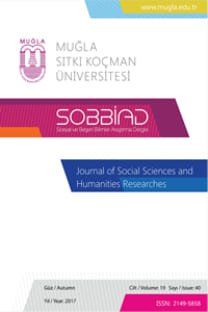Şarkılarla İngilizce Öğretimi (Muğla Örneği)
Bu çalışma, Muğla merkezde bulunan 11 İlköğretim okulunda şarkılarla İngilizce öğretiminin durmunu araştırmayı hedeflemektedir. Veri toplamak için İlköğretim 4. ve 5. sınıf öğrenci ve öğretmenlerine anket uygulanmıştır. Anketle İngilizce öğretiminde şarkıların ne dereceye kadar kullanıldığı; kullanılıyorsa müfredatla ilgili olarak ne tür sorunların yaşandığı sorularına yanıtlar aranmıştır. Ayrıca, çalışmaya öğretmen ve öğrencilerin görüşleri ve önerileri yansıtılmıştır. Çalışmaya 16 İngilizce öğretmeni ve 393 ilköğretim 4. ve 5. sınıf öğrencisici katılmıştır. Araştırma betimleyici bir çalışma olup, elde edilen bulgular SPSS programıyla analiz edilmiştir.
Anahtar Kelimeler:
İngilizce, İngilizce Öğretimi, Müzik, İlköğretim, Muğla
Teaching English through Songs (Practice in Muğla/Turkey)
This study illustrates the current situation of teaching English through songs in primary schools of Muğla / Turkey. The study is based on a questionnaire which was administered to English teachers and 4th and 5th grade students of primary schools in Muğla in order to find answers to such questions as ‘’In teaching English to what extent are songs used ?’’, ‘’What are the problems involved regarding the content of syllabus’’ and What are the suggestions and views put forward by the teachers and students as to teaching English through songs’’ The participants are 16 English teachers and 393 4th and 5th grade students from 11 primary schools in Muğla. Insights gained by the teachers and students are included and evaluated in the study. While assesing the data collected, descriptive method is used.
Keywords:
English, English Teaching, Songs, Primary Schools, Mugla,
___
- Alptekin, Cem; Brain, Mind and Language Learning: “The earlier, the better...”, Ana Dili ve Eğitim Dergisi, Sayı:24, Ocak-Şubat-Mart, Ankara Üniversitesi TÖMER, İzmir, 2002, ss. 61-68.
- Brown. H. Douglas ( 2000 ). Principles of Language Learning and Teaching. Addison Wesley longman, Inc. A Pearson Education Company.
- ---- ( 2001) Teaching by Principles: An Interactive Approach to Language Pedagogy. Second Edition. Addison Wesley longman, Inc. A Pearson Education Company
- Clarke, D. 1989. Materials adaptation: Why leave it all to the teacher? ELT Journal,43, 2, pp. 133- 141.
- Cullen, Brian; “ Music and Song in Discussion”, brian@celtic-otter.com, pp.1-3, Retrieved June 8, 2002 from http://ites/j.org/Techiniquest/cullen- music.html
- Davies, NL; (2000), Learning..... The Beat Goes on; Childhood Education, p.148.
- Edden, J. ( 1198 ) Language and Music in Bearne, Eve. ( Ed.) Use of Language Across the Primary Curriculum. Florence, KY, USA : Routledge.
- http:/site.ebrary.com/lib/mugla/Doc?id=10002259&ppg=154 ( 29.03.2006 ).
- Eken, D. K. ( 1996 ) Ideas for using songs in the language classroom. English Teaching Forum. 34/1 pp.46-47.
- Giudice, G.D. 1986. How to exploit a song in class (We are the world). Modern English Teacher, 14, 4, pp. 33- 36.
- Jensen, Eric; “Implementing Music in the Classroom”, Retrieved June 9, 2002 from http://Songsforteaching.homestead.com/Jensen 1-ns4.html
- Jensen, Eric; “Musical Arts Make Sense”, Song for Teaching, pp. 1-3, http://Songsforteaching.homestead.com/Jensen-ns4.html
- Kotadaki, M. (2002). “A genre-specific approach to the teaching of oral skills in the last two Greek lyceum classes” Symposium of “English for Academic Purposes-a Greek perspective” (26 January 2002). Retrived June 11, 2004 from http://www.tesolgreece.com/260102abstracts.html Krashen, S. 1985.
- The Input Hypothesis. London: Longman
- Lems, Kristin; “ Using Music in the Adult ESL Classroom”, national Center for ESL http://www.cal.org/ncle/digests/music.html.2002 Retrieved June 8, 2002 from
- Littlewood,William ( 1987 ) Foreing and Second Language Learning: Language Acquisition Research and Its Implications for the Classroom. Cambridge University Press, London. p.4
- Lo,R.& Fai Li, H. C. ( 1998 ) Songs enhance learner involvement. English Teaching Forum. 36/3. pp. 8-11.
- Maess, B. & Koelsch; S.(2001), Musical Syntax is processed in Broca’s Area: An MEGstudy. Nature http://Songsforteaching.homestead.com/Rationale html. Retrieved June Nevroscience 8, 2002. 4, pp. 540-545.
- Reeve, C. and J. Williamson 1987. Look what you’ve done to my song. Modern English Teacher, 14, 4, pp. 33- 36.
- Richards J.C. & Rodgers T.S. ( 2001 ) Approaches and Methods in Language Teaching. Cambridge University Press.
- Sarıçoban, A. ve E. Esin, “Songs, Verse and Games in Teaching Grammar ,” The Internet TESL Journal.October, 2000.
- Woodall, Laura and Ziembroski; “Promiting Literacy Through Music”, Retrieved June http://Songsforteaching.homestead.com/Laurabrenda 2-ns4.html. 8, 2002 from
- Wolf, J.; (1992) Let’s Sing it Again, “Creating Music with Young Children, Retrieved
- www.earlychildhood.com/articles/index.cfm?fuseaction=article&A=27- 30k. June 8, 2002
- ISSN: 2149-5858
- Yayın Aralığı: Yılda 2 Sayı
- Başlangıç: 2000
- Yayıncı: Mugla Sitki Kocman University
Sayıdaki Diğer Makaleler
Güç İktidar İlişkisi Bağlamında Kadına Yönelik Şiddet
Sağlık Bakım Profesyoneli Olarak Yetişecek Öğrencilerin Ruhsal Durumları ve Yaklaşımlar
NESRİN AŞTI, GÜLTER ACAR, HATİCE BAĞCI, İSMAİL BAĞCI
Muğla Üniversitesi İdari Personelinin İlaç Kullanma Alışkanlıklarının Belirlenmesi
HÜLYA BAYBEK, DİLEK BULUT, AYDIN ÇAKIR
Küreselleşme ve Yöneticilerin Küreselleşme Sürecine Bakış Açılarının Belirlenmesi
Pierre Bourdieu’nun Toplumsal Eylem Kuramı
Modernden Postmoderne Kültür ve Kimlik
Sigorta Şirketlerinin Satış Performanslarının Veri Zarflama Analizi Yöntemiyle Belirlenmesi
Şarkılarla İngilizce Öğretimi (Muğla Örneği)
ŞEVKİ KÖMÜR, GÜRSAN SARAÇ, HASAN ŞEKER
